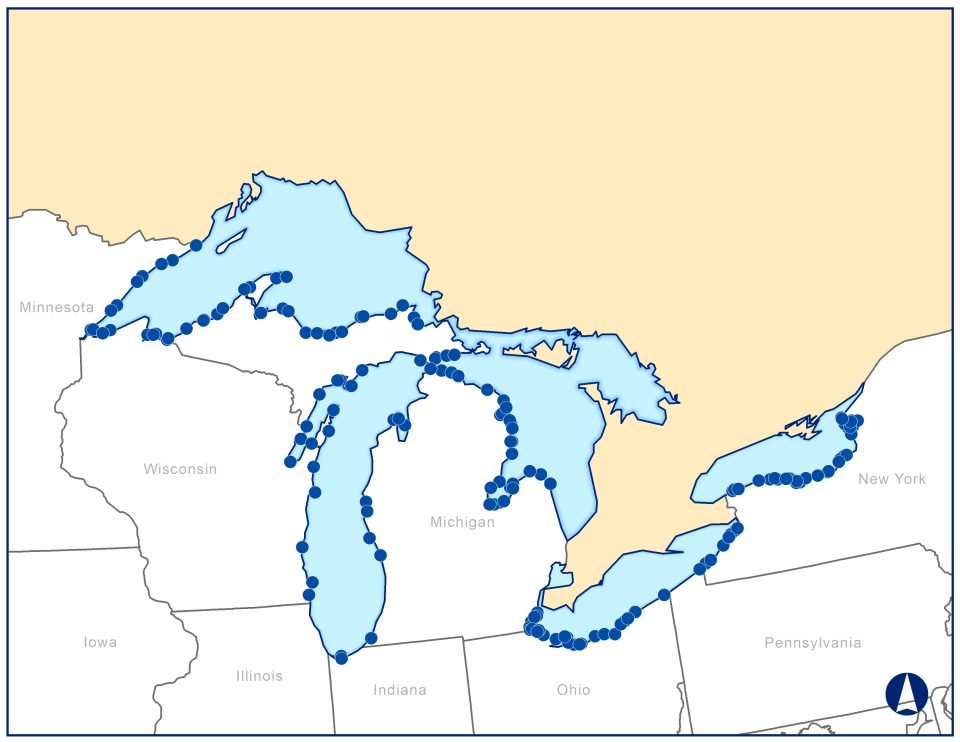2020 Great Lakes Human Health Fish Fillet Tissue Study
Since 2010, the EPA has conducted a series of fish contamination studies as part of the Agency’s National Coastal Condition Assessments that occur in five-year cycles. The National Coastal Condition Assessment (NCCA) 2020 Great Lakes Human Health Fish Fillet Tissue Study is the third statistically based assessment of contaminants in Great Lakes fish. Each Great Lakes fish contamination study conducted under the NCCA involves collection of recreational fish species from randomly selected nearshore sites in the five Great Lakes and analysis of fillet (muscle) tissue for a variety of chemicals to evaluate the potential health impacts for people who eat fish. This study also includes analysis of omega-3 and omega-6 fatty acids. The Fish Tissue Sample Analysis section contains the full list of compounds for this study.
Sampling Design
Sampling sites for this study were randomly selected in nearshore areas along the U.S. coasts of the five Great Lakes. The Great Lakes nearshore area is defined as the region from the shoreline to a depth of 30 meters or to a distance of 5 kilometers in shallower waters of the Great Lakes. A statistically representative subset of 165 sites distributed along the U.S. nearshore area in the five Great Lakes (about 30 sites per lake) were sampled for the 2020 Great Lakes Human Health Fish Fillet Tissue Study.

Fish Sample Collection
Field crews collected fish samples from each of the 165 Great Lakes nearshore sites using hook and line or gill nets. A routine fish composite sample consisted of five fish that met the following criteria:
- All fish in the composite sample are of the same species.
- The fish species in the composite sample is commonly consumed by people.
- All fish in the composite sample either meet legal requirements of harvestable size for the Great Lakes nearshore areas or are at least of consumable size.
- All fish in the composite sample are similar in size, so that the smallest fish in the composite sample is not less than 75% of the total length of the largest fish in the composite sample.
- All fish in the composite sample are collected at the same time
Various species of fish were collected for the 2020 Great Lakes Human Health Fish Fillet Tissue Study. The most frequently caught species included Lake Trout, Smallmouth Bass, Freshwater Drum, and Walleye. These four fish species accounted for 58% of the fish composite samples collected for this study.
Fillet Tissue Sample Preparation
Field crews shipped whole fish samples collected for the 2020 Great Lakes Human Health Fish Fillet Tissue Study to a laboratory designated by the EPA for preparation of fillet tissue composite samples. Experienced laboratory staff filleted the fish (removing scales but retaining the skin and the belly flap on each fillet) and homogenized the fillet tissue in a strictly controlled environment to avoid contaminating the fish tissue samples. The homogenized fillet composite samples were divided into aliquots containing adequate tissue for each type of chemical analysis before being shipped to laboratories under contract to the EPA for analysis of the target chemical contaminants and fatty acids included in the study.
Fillet Tissue Sample Analysis
Laboratories analyzed the 2020 Great Lakes fillet tissue samples for the following chemicals:
- Mercury (total)
- Per- and polyfluoroalkyl compounds or PFAS (40 compounds)
- Polychlorinated biphenyls or PCBs (all 209 congeners)
- Polychlorinated biphenyls as Aroclors or PCBs as Aroclors (7 common Aroclor mixtures plus Aroclor 1268)
- Omega-3 and Omega-6 fatty acids (38 fatty acids)
Laboratories used the following chemical-specific methods for analysis of the 2020 Great Lakes Human Health Fish Fillet Tissue Study fillet samples:
- Mercury: EPA Method 1631E, Mercury in Water by Oxidation, Purge and Trap, and Cold Vapor Atomic Fluorescence Spectrometry, EPA 821-R-02-019, August 2002.
- PFAS: There were no EPA methods for analysis of fish tissue at the time of the study, so fillet samples were analyzed by an in-house procedure developed by the commercial laboratory, similar to EPA Method 1633, utilizing liquid chromatography with tandem mass spectrometric detection (LC/MS/MS).
- PCBs: EPA Method 1668C, Chlorinated Biphenyl Congeners in Water, Soil, Sediment, Biosolids, and Tissue by High Resolution Gas Chromatography/High Resolution Mass Spectrometry (HRGC/HRMS), EPA 820-R-10-005, April 2010.
- PCBs as Aroclors: EPA Method 8082A, Polychlorinated Biphenyls (PCBs) by Gas Chromatography, EPA publication SW-846, February 2007.
- Omega-3 and Omega-6 fatty acids: The method applied for fatty acid analysis used a combination of an extraction procedure described by Sathivel et al. (2002) and an Association of Official Analytical Chemists (AOAC) analytical method for derivatization of the fatty acids to their methyl esters, followed by gas chromatographic analysis with a flame ionization detector (GC/FID); there is no standardized EPA method for analysis of fatty acids.
Results and Data
All results for the fillet tissue concentrations are reported on a wet weight basis. All the fish fillet samples analyzed contained detectable levels of mercury, PCBs and PFAS. Analytical and field sampling data for each 2020 NCCA Great Lakes Human Health Fish Fillet Tissue Study chemical contaminant are provided, along with a data dictionary that describes the contents of each data file, a quality assurance report, the quality assurance project plans for the study, and a link to the 2020 NCCC online report and technical support document.
- Mercury Data (xlsx)
- PFAS Data (xlsx)
- PCB Congeners Data (xlsx)
- PCB Aroclors Data (xlsx)
- Fatty Acids Data (xlsx)
- Data Dictionary – Mercury, PFAS and PCB Congeners (pdf)
- Data Dictionary – PCB Aroclors (pdf)
- Data Dictionary – Fatty Acids (pdf)
- Quality Assurance Report (pdf)
- Quality Assurance Project Plan for Sample Preparation (pdf)
- Quality Assurance Project Plan for Sample Analysis (pdf)
- National Coastal Condition Assessment 2020 Final Report and Technical Support Document (coming soon!)
